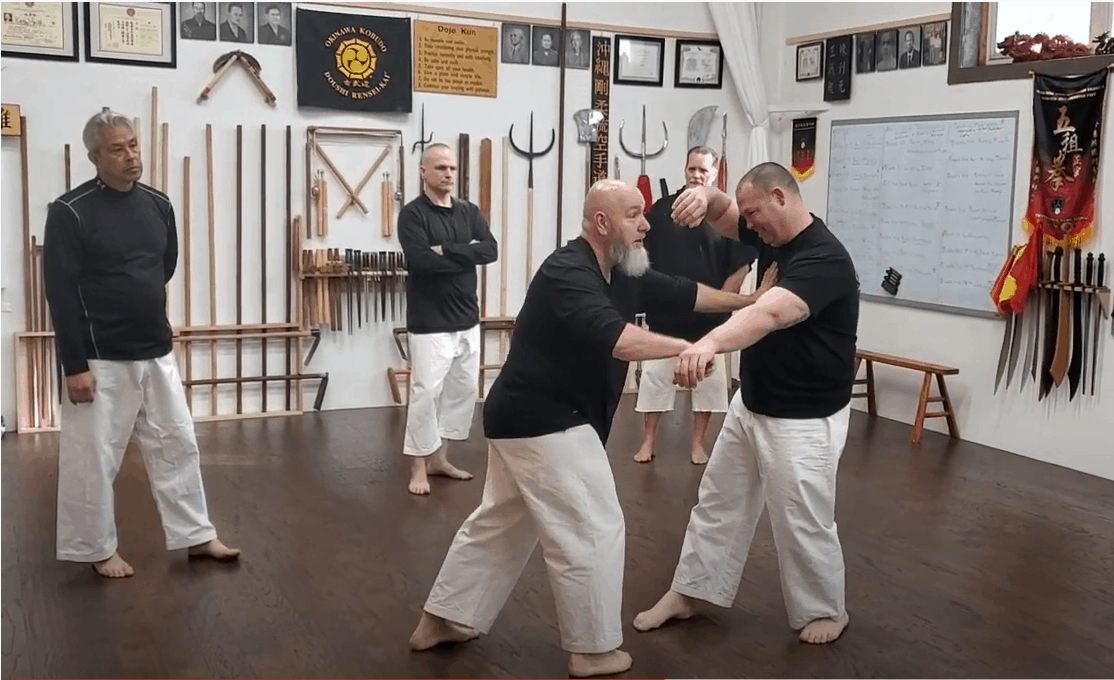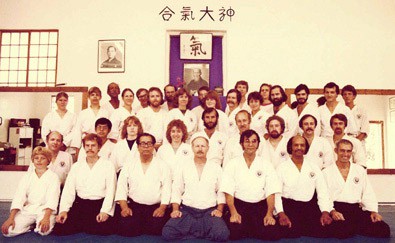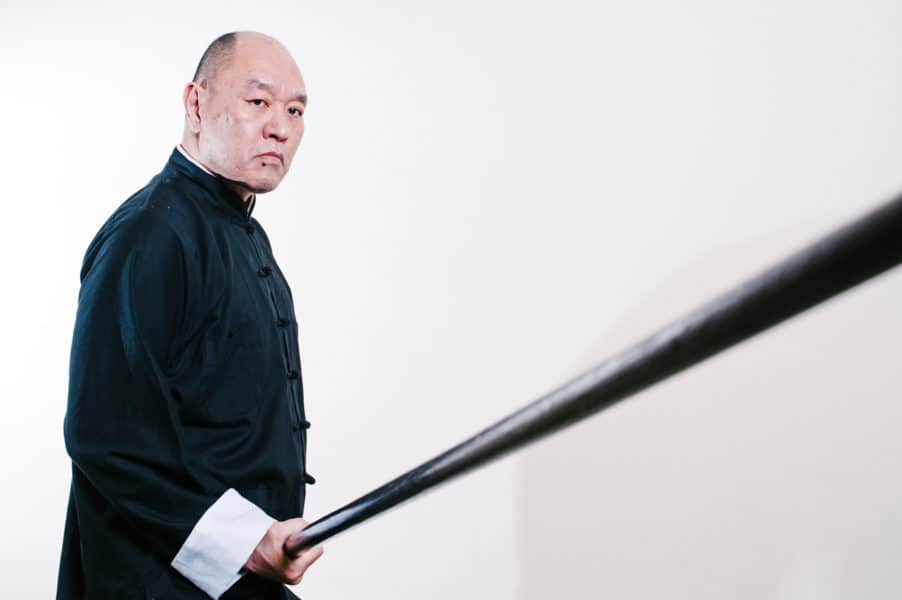[et_pb_section fb_built=”1″ _builder_version=”4.6.6″ _module_preset=”default” custom_padding=”||19px|||”][et_pb_row _builder_version=”4.6.6″ _module_preset=”default” custom_padding=”||1px|||”][et_pb_column type=”4_4″ _builder_version=”4.6.6″ _module_preset=”default”][et_pb_text _builder_version=”4.6.6″ _module_preset=”default”]
By Russ L. Smith
We are typically assuming in a self-defense scenario, that the defender is first acting in the after, as the attacker is the one initiating the action, acting before the defender. If we liken a fight to a dance, the attacker is leading the dance, and the defender is following…acting in the after, responding to the leader, merely reacting. The leader acts according to their whim, unimpeded, the follower has the difficult task of keeping up. The leader of the dance is acting in the before. The leader is deciding where on the floor the dance moves will take both dancers. The follower is merely along for the ride, with no control, and no say, as they are acting in the after.
Next, let’s move away from the dance analogy, back to the self-defense scenario. We’ve discussed how important it is to move as the defender as quickly as possible from defend yourself, which we defined as an after activity, to control the attacker, which is most successful when performed in the before, because of the inherent difficulty in reacting efficiently.
But, with the assumption that we are starting in the after, how can a defender change the situation, such that they move from the after to the before? The defender can do so by acting both efficiently and effectively in the during, and the following are the two primary methods that can be used:
1. Counter-attacking while we block/receive or otherwise defend against the attacker, or
2. Attaining some additional form of control WITH our defensive motion. (breaking the attacker’s balance, inflict pain, etc.)
Option 1:
Counter-attacking while blocking/receiving an attack
Given the first principle of self-defense, defend yourself, control your attacker, is in two parts, the most efficient thing to do is perform both parts at the same time. If we do so, we can change the situation to something like the following:
1. Attacker attempts to control defender
2. Defender succeeds at defending, while at the same time applying a form of counter-control
3. Attacker foregoes their second attack and switches to defending the incoming control
4. Defender continues counter-control
5. Attacker continues defending
Until which point the attacker fails to defend…leading to the defender’s success at counter-controlling. As you see, the key to moving from the after (Step 1), through the during (Step 2), into the before (Step 4) requires that we enlist some form of aggressive counter-control as early as possible, and simultaneous to our defense.
The following example demonstrates all three timings, acting in defense only while in the after, counter-attacking (while blocking) in the during, and striking again in the before. As you can see in the example, we start with the assumption that the defender is in the after, perhaps caught unaware, only able to defend ourselves…which does little to change the defender’s situation. At this point, the defender is merely blocking, still stuck in the first half of defend yourself, control your attacker.
[/et_pb_text][/et_pb_column][/et_pb_row][et_pb_row _builder_version=”4.6.6″ _module_preset=”default” custom_margin=”|auto|-29px|auto||”][et_pb_column type=”4_4″ _builder_version=”4.6.6″ _module_preset=”default”][et_pb_image src=”https://tambulimedia.com/wp-content/uploads/2020/12/Clip-1.png” title_text=”Russ Smith Karate” align=”center” admin_label=”Pic 1″ _builder_version=”4.6.6″ _module_preset=”default”][/et_pb_image][/et_pb_column][/et_pb_row][et_pb_row _builder_version=”4.6.6″ _module_preset=”default” custom_padding=”||0px|||”][et_pb_column type=”4_4″ _builder_version=”4.6.6″ _module_preset=”default”][et_pb_text _builder_version=”4.6.6″ _module_preset=”default” custom_margin=”-14px|||||”]
The defender has blocked upward, creating an opening to the middle and lower levels, and (as executed) the defender’s block has only served to keep the defender safe a moment longer…it has not interrupted, or otherwise controlled the attacker. The attacker continues, planning to exploit the defender’s opening with a second punch. The defender blocks downward to defend the exposed area, but simultaneously counter- punches, stealing the initiative from the attacker by both blocking and striking in the during.
[/et_pb_text][/et_pb_column][/et_pb_row][et_pb_row _builder_version=”4.6.6″ _module_preset=”default”][et_pb_column type=”4_4″ _builder_version=”4.6.6″ _module_preset=”default”][et_pb_image src=”https://tambulimedia.com/wp-content/uploads/2020/12/clip-2.png” title_text=”clip 2″ align=”center” admin_label=”russ 2″ _builder_version=”4.6.6″ _module_preset=”default” custom_margin=”-22px|||||”][/et_pb_image][/et_pb_column][/et_pb_row][et_pb_row column_structure=”2_5,3_5″ _builder_version=”4.6.6″ _module_preset=”default” custom_margin=”-12px|auto||auto||” custom_padding=”0px||0px|||”][et_pb_column type=”2_5″ _builder_version=”4.6.6″ _module_preset=”default”][et_pb_image src=”https://tambulimedia.com/wp-content/uploads/2020/12/clip-3.png” title_text=”clip 3″ _builder_version=”4.6.6″ _module_preset=”default” custom_padding=”|0px||||”][/et_pb_image][/et_pb_column][et_pb_column type=”3_5″ _builder_version=”4.6.6″ _module_preset=”default”][et_pb_text _builder_version=”4.6.6″ _module_preset=”default”]
Landing a punch, the defender has now taken the attacker’s mind, albeit temporarily, by slowing down and interrupting the attacker’s OODA loop, which had been planning to throw a 3rd punch. Since the defender’s right hand is already in position for a second attack (mere inches from the target), he throws the punch, now acting in the before. Note that this example, in its mid and final stages, also enlists several principles, such as closest weapon / closest target, and keep weapons on-line, which will be further described in this chapter and in chapter 4.
[/et_pb_text][/et_pb_column][/et_pb_row][et_pb_row _builder_version=”4.6.6″ _module_preset=”default”][et_pb_column type=”4_4″ _builder_version=”4.6.6″ _module_preset=”default”][et_pb_text _builder_version=”4.6.6″ _module_preset=”default” min_height=”722px” custom_margin=”-13px|||||” custom_padding=”||0px|||”]
Other examples of applications that work under this approach to counter-attacking efficiently in the during, include:
▪ Using body motion, such as dodging, angling, or ducking (in lieu of blocking/receiving), while counter-striking from the safe position.
▪ Using the arm(s) to block/receive while simultaneously kicking or otherwise disrupting the attacker’s legs.
Option 2:
Attaining some additional form of control WITH our defensive motion.
The prior method is an example of how to in the during enlist both sides of the body simultaneously, each working in a different role…one hand working defensively, while the other hand works offensively.
This alternative option for acting efficiently in the during is to perform a singular initial motion that is multi-purpose, yet not complex and time-consuming. This defense as offense requires the defender perform a more advanced defensive maneuver that “stacks” principles (all discussed in great detail in this chapter as well as in chapters 4 and 5), such as the following:
▪ Stretching techniques,
▪ Closest weapon/closest target,
▪ Three gates/three segments,
▪ Keep weapons on-line,
▪ Unified body,
▪ Strong vs weak,
▪ Attack the opponent’s posture and balance, and
▪ Seek the center
A simple example of this is a singular blocking/receiving motion that disrupts the attacker’s balance, which also disrupts the attacker’s second punch and allows for a counter-punch that is less likely to be blocked by the attacker.
**This article was excerpted from Russ L. Smith’s boook, Principle-Driven Skill Development in Traditional Martial Arts. Click the book cover for more information, and watch the video for additional insights.**
[/et_pb_text][/et_pb_column][/et_pb_row][et_pb_row column_structure=”2_5,3_5″ _builder_version=”4.6.6″ _module_preset=”default” custom_padding=”0px|||||”][et_pb_column type=”2_5″ _builder_version=”4.6.6″ _module_preset=”default”][et_pb_image src=”https://tambulimedia.com/wp-content/uploads/2018/05/Principle-Driven-Skills-Cover-7×10-100-dpi.jpg” alt=”product image” title_text=”Principle Driven Skills – Russ Smith” url=”https://tambulimedia.com/japanese-okinawan-martial-arts-welcome/principle-driven-skill-development/” admin_label=”book” _builder_version=”4.6.6″ _module_preset=”default” width=”74%”][/et_pb_image][/et_pb_column][et_pb_column type=”3_5″ _builder_version=”4.6.6″ _module_preset=”default”][et_pb_image src=”https://tambulimedia.com/wp-content/uploads/2020/12/Russ-Smith-Timing.png” title_text=”Russ Smith Timing” url=”https://www.youtube.com/watch?v=6Rg8gN1xqJc” _builder_version=”4.6.6″ _module_preset=”default” custom_margin=”|||-98px||” custom_padding=”|||0px||”][/et_pb_image][/et_pb_column][/et_pb_row][et_pb_row _builder_version=”4.6.6″ _module_preset=”default” custom_padding=”0px|||||”][et_pb_column type=”4_4″ _builder_version=”4.6.6″ _module_preset=”default”][et_pb_text _builder_version=”4.6.6″ _module_preset=”default”]
Rave Reviews
“Identifies and describes numerous application principles from all the potentially precursor influences on Goju-ryu. Most importantly, it discusses in extreme detail those closely-guarded secrets known by some, and vigorously ought by early Okinawan Karate pioneers, who were interested in the revered fighting arts of Fuzhou.” —Patrick McCarthy, Hanshi 9th Dan
“Explores the principles behind most martial training. This is the spine of the art…. Examples cover and interlock all sorts of concepts. There is a section on timing, tools (xing), power (gong), methods and more. His applications make you nod in agreement. His techniques could keep you in lesson plans for uncountable hours.” —Sifu Ted Mancuso, Kaimen & Plumb Pub
“Russ Smith, presents an insightful, intriguing survey of the Okinawan Goju-Ryu Karate style through the perspective of its Chinese influences..” —Sensei Marcus Davila, Okinawan Goju-Ryu Karate
“This is not simply a personal take on training and teaching. It is based in the use of directly transmitted (i.e., clearly taught) principles found in some Southern Chinese martial arts.” –Sensei Fred Lohse, Chief Instructor, Boston Kodokan
“Russ Smith is one of the most clear-thinking and progressive instructors of traditional martial arts today. His book shows the how and why of training that brings traditional practice into modern times.” —Dr. Mark Wiley, Beng Hong Athletic Assoc.
[/et_pb_text][/et_pb_column][/et_pb_row][et_pb_row _builder_version=”4.6.6″ _module_preset=”default” column_structure=”1_4,1_4,1_4,1_4″][et_pb_column _builder_version=”4.6.6″ _module_preset=”default” type=”1_4″][et_pb_image src=”https://tambulimedia.com/wp-content/uploads/2018/05/Principle-Driven-Skills-Cover-7×10-100-dpi.jpg” _builder_version=”4.6.6″ _module_preset=”default” alt=”product image” title_text=”Principle Driven Skills – Russ Smith” admin_label=”Russ” url=”https://tambulimedia.com/japanese-okinawan-martial-arts-welcome/principle-driven-skill-development/” hover_enabled=”0″ sticky_enabled=”0″][/et_pb_image][/et_pb_column][et_pb_column _builder_version=”4.6.6″ _module_preset=”default” type=”1_4″][et_pb_image src=”https://tambulimedia.com/wp-content/uploads/2020/11/Filipino-Fighting-Arts-Vol.-1-Cover-scaled.jpg” _builder_version=”4.6.6″ _module_preset=”default” alt=”product image” title_text=”Filipino Fighting Arts – Mark V. Wiley” url=”https://tambulimedia.com/filipino-martial-arts-welcome/filipino-fighting-arts-volume-1/?et_fb=1&PageSpeed=off” admin_label=”FFA” hover_enabled=”0″ sticky_enabled=”0″][/et_pb_image][/et_pb_column][et_pb_column _builder_version=”4.6.6″ _module_preset=”default” type=”1_4″][et_pb_image src=”https://tambulimedia.com/wp-content/uploads/2016/07/Iron-Skills-Cover-sm.jpg” _builder_version=”4.6.6″ _module_preset=”default” title_text=”Iron Skills Cover (sm)” url=”https://tambulimedia.com/chinese-martial-arts-welcome/fundamental-iron-skills/” admin_label=”Iron” hover_enabled=”0″ sticky_enabled=”0″][/et_pb_image][/et_pb_column][et_pb_column _builder_version=”4.6.6″ _module_preset=”default” type=”1_4″][et_pb_image src=”https://tambulimedia.com/wp-content/uploads/2019/09/American-Kenpo-Karate-book-Cover-Irv-Gill-Tambuli-Media.jpg” _builder_version=”4.6.6″ _module_preset=”default” title_text=”American Kenpo Karate Book by Irvin Gill – Tambuli Media” url=”https://tambulimedia.com/martial-arts-welcome/american-kenpo-karate/” admin_label=”kenpo” hover_enabled=”0″ sticky_enabled=”0″][/et_pb_image][/et_pb_column][/et_pb_row][/et_pb_section]





